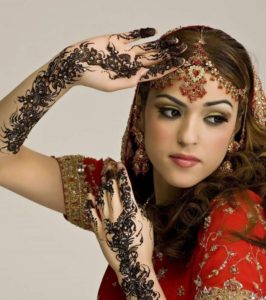 The art of applying henna to the hands and feet is known as Mehndi. Henna is traditionally used for special occasions like holidays, birthdays and weddings in India, Pakistan, and the Middle East. Henna is all natural and completely safe for all skin types. The most popular of the traditions is the Mehndi Night where the bride, her family, relatives and friends get together to celebrate the wedding to come. Every culture and region of the world uses henna tattoos in its own unique way. Indian tattoos feature fine lines and floral patterns, while Arabic henna designs tend to be larger in scale and African henna patterns are more bold and geometric. The art of henna has been practiced for years and today It became a very popular form of temporary body decoration and has become a growing trend ever since.
The art of applying henna to the hands and feet is known as Mehndi. Henna is traditionally used for special occasions like holidays, birthdays and weddings in India, Pakistan, and the Middle East. Henna is all natural and completely safe for all skin types. The most popular of the traditions is the Mehndi Night where the bride, her family, relatives and friends get together to celebrate the wedding to come. Every culture and region of the world uses henna tattoos in its own unique way. Indian tattoos feature fine lines and floral patterns, while Arabic henna designs tend to be larger in scale and African henna patterns are more bold and geometric. The art of henna has been practiced for years and today It became a very popular form of temporary body decoration and has become a growing trend ever since.
Henna:
The English name “henna” comes from the Arabic word Hinna. Henna tree is a flowering plant that grows 12-15 feet high and comes from the sole species of the Lawsonia genus. Henna has been used for centuries to dye skin, hair, and fingernails, as well as fabrics including silk, wool, and leather.
Body Decorations:
For body decorations, the leaves of the henna plant are dried, crushed into a fine powder, and made into a creamy paste using a variety of techniques. This paste is then applied to the skin, staining the top layer. In its natural state it will dye the skin an orange or brown color. Although it looks dark green when applied, this green paste will flake off revealing an orange stain. The palms and the soles of the feet stain the darkest because the skin is the thickest in these areas & contain the most keratin. The designs generally last from 1-4 weeks on the skin surface depending on the henna, care and skin type.
Designs:
All henna designs are free hand designs and can be modified as per requests. For best color apply mix of sugar and lemon juice over the dried henna design and leave the paste on for 4 to 6 hours. When your design is dry it flakes off and later you can scrub off the remaining paste. How dark your henna gets depends upon the area applied, as well as your skin warmth.
Medicinal Properties:
Henna is considered an herb, and has long been known to have healing qualities. In ancient times it has been applied for such ailments as headaches, stomach pains, burns (including sunburns), open wounds, as a fever reducer, athlete’s foot and even the prevention of hair loss. In the traditional system of medicine, leaf paste is applied twice a day, on the affected parts to cure impetigo, with use of henna revealed anti-inflammatory, antipyretic and analgesic effects of henna.
How long does a Henna Tattoo last?
This depends on few factors like skin type, life style and body part but generally speaking the design will last somewhere between three to four weeks.

